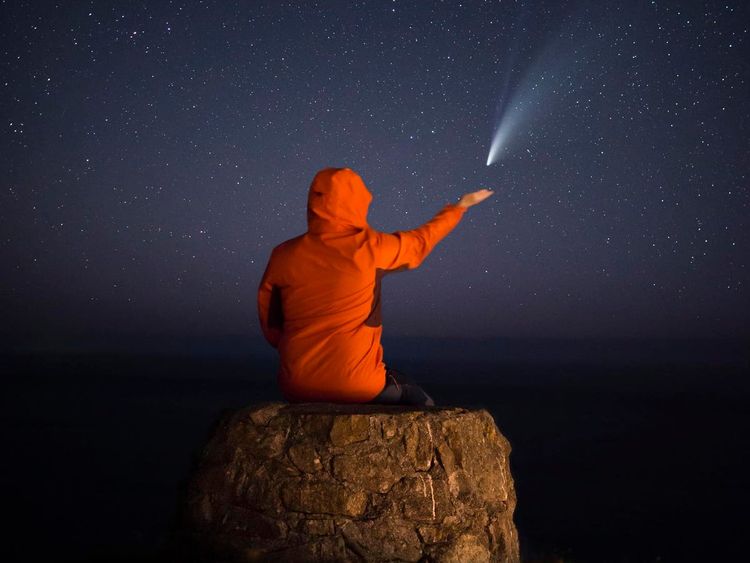The 'Green Comet' Skychart You Need To See It This Weekend ...

Comet C/2022 E3 (ZTF) will this week be very close to Capella, the brightest star in the ... [+] constellation Auriga (2020's comet NEOWISE is pictured).
gettyGo outside an hour or two after sunset on Sunday, February 5, 2023, find a particular bright star, then use a pair of binoculars to look around it.
That’s how you’ll see comet C/2022 E3 (ZTF)—the likely “comet the year”—which is now just visible from the northern hemisphere after dark. It looks like a smudge on the sky—it’s not green to the human eye, as images on social media show it.
On its closest approach this Wednesday, February 1 into Thursday, February 2, 2023 it’s about 93 million miles/150 million kilometers distant.
MORE FROM FORBESSnow Moon 2023: Exactly When To See February's Full Moon Rise From Where You LiveBy Jamie Carter
Unfortunately, the waxing Moon is almost full and getting so bright it’s playing havoc with comet-viewing.
That extra light pollution doesn’t help, but regardless it’s not the easiest thing to find in the night sky.
However, this weekend the comet will be close to Capella, the “golden star”—the brightest in the constellation of Auriga (the “charioteer”) and the sixth-brightest star in the night sky.
This is what it will look like (though somewhat fainter):
A view of the rare comet, C/2022 E3 (ZTF), over the night sky of the town of Veliko Tarnovo, the ... [+] comet which was first discovered by scientists less than a year ago using the wide-field survey camera at the Zwicky Transient Facility. In March 2022, the comet was spotted in Jupiter's orbit. The comet is believed to come from the Oort Cloud, the most distant region of our solar system, which has been called the ''home of the comets,'' particularly long-period comets. The comet was closest to the Sun on Jan. 12, and it will make its closest sweep by Earth on Feb. 1 and Feb. 2 Catching the C/2022 E3 (ZTF) is literally a once-in-a-lifetime opportunity. It's not going to pass by Earth again for a really long time. (Photo by Petar Petrov /Sky Picrures Bulgaria/NurPhoto via Getty Images)
NurPhoto via Getty ImagesCapella means “the little goat” in Latin. The “goat star” also has two smaller stars nearby—“The Kids”—which comet C/2022 E3 (ZTF) will also appear to visit, one of them very closely.
Comet C/2022 E3 (ZTF) is not easily visible to the naked eye—so you’re going to need to scan around Capella with binoculars or a small telescope to see it.
However, since Capella is so bright this is a fabulous opportunity to take your gaze straight to the comet.
Here’s how to do that this weekend:
How to see find Capella, the ‘Golden Star’.
Stellarium/Jamie Carter How to see find Capella, the ‘Golden Star’Capella will be high in the sky a couple of hours after sunset. Look due east and go straight up to the zenith—way above the Moon. It will be just below Mars. Like many of the bright stars in our night sky, Capella is actually two stars, Capella A and Capella B, both yellow giant stars, but we can only see one point of light. They’re 43 light years from us.
How to see comet C/2022 E3 (ZTF) on Saturday, February 4, 2023
Stellarium How to see comet C/2022 E3 (ZTF) on Saturday, February 4, 2023Tonight you can see comet C/2022 E3 (ZTF) approaching the constellation of Auriga, and Capella in particular.
How to see comet C/2022 E3 (ZTF) on Sunday, February 5, 2023
Stellarium How to see comet C/2022 E3 (ZTF) on Sunday, February 5, 2023Comet C/2022 E3 (ZTF) will tonight be in the same field of view in a pair of binoculars as Capella. This is also the night of the rising of the full Moon. Light pollution from the Moon will make a big a touch harder to find, but its closeness to Capella makes this a great opportunity to see comet C/2022 E3 (ZTF).
How to see comet C/2022 E3 (ZTF) on Monday, February 6, 2023
Stellarium How to see comet C/2022 E3 (ZTF) on Monday, February 6, 2023Look at Capella tonight and you’ll see the comet C/2022 E3 (ZTF) has gone. It will now be beside the star Saclateni, which is close to another bright star, Haedus. These two stars—easy to see with the naked eye—are close to Capella and two of the three stars known as “The Kids.” You’re best off finding both together to confirm you’ve got the correct star.
How to see the ‘green comet’ using binocularsYou need binoculars or a small telescope. At a magnitude of 5 it’s theoretically visible to naked eyes from a truly dark sky site, but the bright Moon has other ideas.
The easiest way is to use a pair of binoculars—7x42 or 10x50 binocular are perfect (or somewhere in between).
Wishing you clear skies and wide eyes.


























































